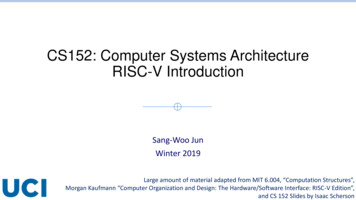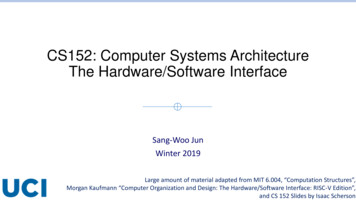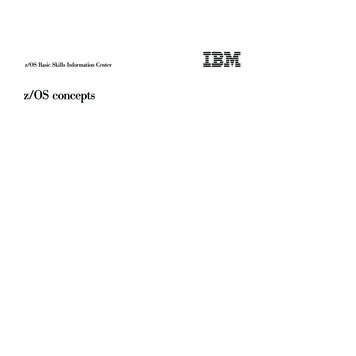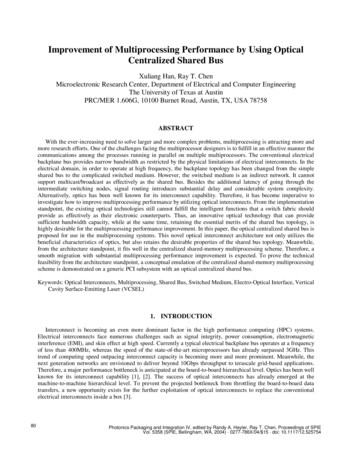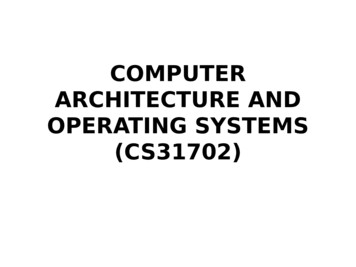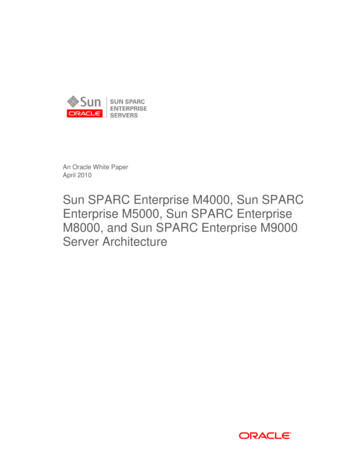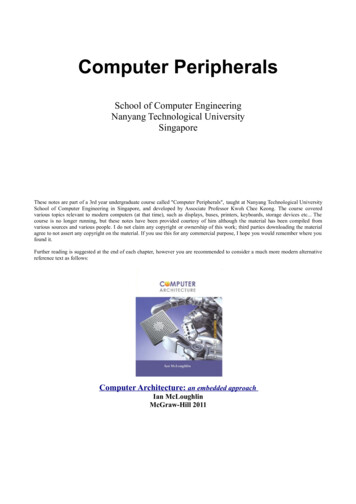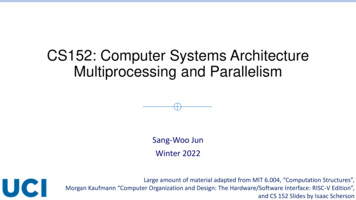
Transcription
CS152: Computer Systems ArchitectureMultiprocessing and ParallelismSang-Woo JunWinter 2022Large amount of material adapted from MIT 6.004, “Computation Structures”,Morgan Kaufmann “Computer Organization and Design: The Hardware/Software Interface: RISC-V Edition”,and CS 152 Slides by Isaac Scherson
Why focus on parallelism? Of course, large jobs require large machines with many processorso Exploiting parallelism to make the best use of supercomputers have always beenan extremely important topic But now even desktops and phones are multicore!o Why? The end of “Dennard Scaling”What happened?
Option 1: Continue Scaling Frequency atIncreased Power Budget0.014 μ
But Moore’s Law Continues Beyond 2006
State of Things at This Point (2006) Single-thread performance scaling endedo Frequency scaling ended (Dennard Scaling)o Instruction-level parallelism scaling stalled also around 2005 Moore’s law continueso Double transistors every two yearso What do we do with them?Instruction Level ParallelismK. Olukotun, “Intel CPU Trends”
Crisis Averted With Manycores?
Crisis Averted With Manycores?We’ll get back to this point later. For now, multiprocessing!
The hardware for parallelism:Flynn taxonomy (1966) recapData e-Core Processors)SIMD(GPUs, Intel SSE/AVX extensions, )MultiMISD(Systolic Arrays, )MIMD(VLIW, Parallel Computers)
Flynn taxonomySingle-InstructionSingle-Data(Single-Core Processors)Single-InstructionMulti-Data(GPUs, Intel SIMD lic Arrays, )Multi-InstructionMulti-Data(Parallel Processors)
Shared memory multiprocessor Shared memory multiprocessoro Hardware provides single physicaladdress space for all processorso Synchronize shared variables using lockso Memory access time UMA (uniform) vs. NUMA (nonuniform) SMP: Symmetric multiprocessoro The processors in the system are identical, and are treated equally Typical chip-multiprocessor (“multicore”) consumer computers
UMA between cores sharing a package,But NUMA across cores in different packages.Overall, this is a NUMA systemMemory System ArchitecturePackageCoreCoreL1 I PackageL1 I L1 D L1 D L1 I L2 L2 CoreCoreL1 I L1 D L2 L2 L3 L3 QPI / UPIDRAML1 D DRAM
Memory System Bandwidth Snapshot(2021)ProcessorCache Bandwidth Estimate64 Bytes/Cycle 200 GB/s/CoreProcessorDDR4 2666 MHz128 GB/sQPI / UPIDRAMUltra Path InterconnectUnidirectional20.8 GB/sDRAMMemory/PCIe controller used to be on a separate “North bridge” chip, now integrated on-dieAll sorts of things are now on-die! Even network controllers!
Memory system issues with multiprocessing(1) Suppose two CPU cores share a physical address spaceo Distributed caches (typically L1)o Write-through caches, but same problem for write-back as wellTime EventstepCPU A’scacheCPU B’scache0Memory01CPU A reads X002CPU B reads X0003CPU A writes 1 to X101Wrong data!
Memory system issues with multiprocessing(2) What are the possible outcomes from the two following codes?o A and B are initially zeroProcessor 1:Processor 2:1: A 1;2: print B3: B 1;4: print Ao 1,2,3,4 or 3,4,1,2 etc : “01”o 1,3,2,4 or 1,3,4,2 etc : “11”o Can it print “10”, or “00”? Should it be able to?“Memory model” defines what is possible and not(Balance between performance and ease of use)
Memory problems with multiprocessing Cache coherency (The two CPU example)o Informally: Read to each address must return the most recent valueo Complex and difficult with many processorso Typically: All writes must be visible at some point, and in proper order Memory consistency (The two processes example)o How updates to different addresses become visible (to other processors)o Many models define various types of consistency Sequential consistency, causal consistency, relaxed consistency, o In our previous example, some models may allow “10” to happen, and we mustprogram such a machine accordinglyGrad level topic
CS152: Computer Systems ArchitectureCache Coherency IntroductionSang-Woo JunWinter 2022Large amount of material adapted from MIT 6.004, “Computation Structures”,Morgan Kaufmann “Computer Organization and Design: The Hardware/Software Interface: RISC-V Edition”,and CS 152 Slides by Isaac Scherson
The cache coherency problem All cores may have their own cached copies for a memory location Copies become stale if one core writes only to its own cache Cache updates must be propagated to other coreso All cores broadcasting all writes to all cores undermines the purpose of cacheso We want to privately cache writes without broadcasting, whenever possibleWe expect Mem[X] 2Mem[X] ;Mem[X] ;Core 0Core 0Wrong!
Background: On-chip interconnect An interconnect fabric connects cores and private caches to upper-levelcaches and main memoryo Many different paradigms, architectures, and topologies Packet-switched vs. Circuit-switched vs. Ring topology vs. Tree topology vs. Torus topology vs. Data-driven decision of best performance/resource ared Cache
Background: Bus interconnect A bus is simply a shared bundle of wireso All data transfers are broadcast, and all entities on the bus can listen to allcommunicationo All communication is immediate, single cycleo Only one entity may be transmitting at any given clock cycleo If multiple entities want to send data (a “multi-master” configuration) a separateentity called the “bus arbiter” must assign which master can write at a given cycleCPU CacheCPU CacheCPU CacheShared Cache
Background: Mesh interconnect Each core acts as a network switcho Compared to bus, much higher aggregate bandwidth Bus: 1 message/cycle, Mesh: Potentially as many messages as there are linkso Much better scalability with more coreso Variable cycles of latencyo A lot more transistors to implement, compared to busCPU CacheCPU CacheCPU CacheCPU CacheCPU CacheCPU CacheShared CacheDesktop-class multicores migrating from busses to meshes (As of 2022)Here we use busses for simplicity of description
Keeping multiple caches coherent Basic ideao If a cache line is only read, many caches can have a copyo If a cache line is written to, only one cache at a time may have a copy Writes can still be cached (and not broadcast)! Typically two ways of implementing thiso “Snooping-based”: All cores listen to requests made by others on the memory buso “Directory-based”: All cores consult a separate entity called “directory” for eachcache access
Snoopy cache coherence All caches listen (“snoop”) to the traffic on the memory buso Some new information is added to read/write requests Before writing to a cache line, each core must broadcast its intentiono All other caches must invalidate its own copieso Algorithm variants exist to make this work effectively (MSI, MSIE, )AddrMem[X]Value10CPU Cache“I want to write to X”AddrValueMem[X]0CPU CacheAddrMem[X]Value201CPU Cache“dirty” instance can exist inonly one place!Many cores writing to X maycause ping pong read from“I want to writeto X”X”Shared Cache
Performance issue with cache coherence:False sharing Different memory locations, written to by different cores, mapped tosame cache lineo Core 1 performing “results[0] ;”o Core 2 performing “results[1] ;” Remember cache coherenceo Every time a cache is written to, all other instances need to be invalidated!o “results” variable is ping-ponged across cache coherence every timeo Bad when it happens on-chip, terrible over processor interconnect (QPI/UPI) Solution: Store often-written data in local variables
Some performance numberswith false sharing
Hardware support for synchronization In parallel software, critical sections implemented via mutexes are criticalfor algorithmic correctness Can we implement a mutex with the instructions we’ve seen so far?o e.g.,while (lock False);lock True;// critical sectionlock False;o Does this work with parallel threads?
Hardware support for synchronization By chance, both threads can think lock is not takeno e.g., Thread 2 thinks lock is not taken, before thread 1 takes ito Both threads think they have the lockThread 1Thread 2while (lock False);while (lock False);lock True;lock True;// critical section// critical sectionlock False;lock False;Algorithmic solutions exist! Dekker’s algorithm, Lamport’s bakery algorithm
Hardware support for synchronization A high-performance solution is to add an “atomic instruction”o Memory read/write in a single instructiono No other instruction can read/write between the atomic read/writeo e.g., “if (lock False) lock True”Single instruction read/write is in the grey area of RISC paradigm
RISC-V example Atomic instructions are provided as part of the “A” (Atomic) extension Two types of atomic instructionso Atomic memory operations (read, operation, write) operation: swap, add, or, xor, o Pair of linked read/write instructions, where write returns fail if memory has beenwritten to after the read More like RISC! With bad luck, may cause livelock, where writes always fail Aside: It is known all synchronization primitives can be implemented withonly atomic compare-and-swap (CAS)o RISC-V doesn’t define a CAS instruction though
Pipelined implementation of atomicoperations In a pipelined implementation, even a single-instruction read-modifywrite can be interleaved with other instructionso Multiple cycles through the pipeline Atomic memory operationso Modify cache coherence so that once an atomic operation starts, no other cachecan access ito Other solutions?
An interconnect fabric connects cores and private caches to upper-level caches and main memory o Many different paradigms, architectures, and topologies Packet-switched vs. Circuit-switched vs. Ring topology vs. Tree topology vs. Torus topology vs. Data-driven decision of best performance/resource trade-off Shared Cache Core Cache
